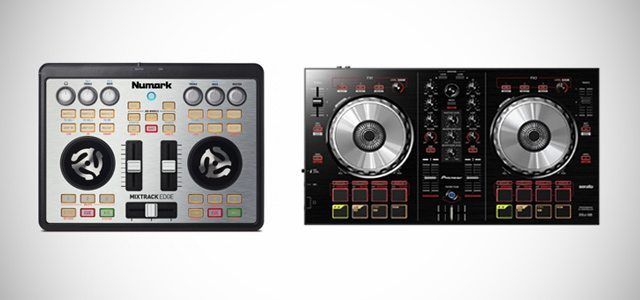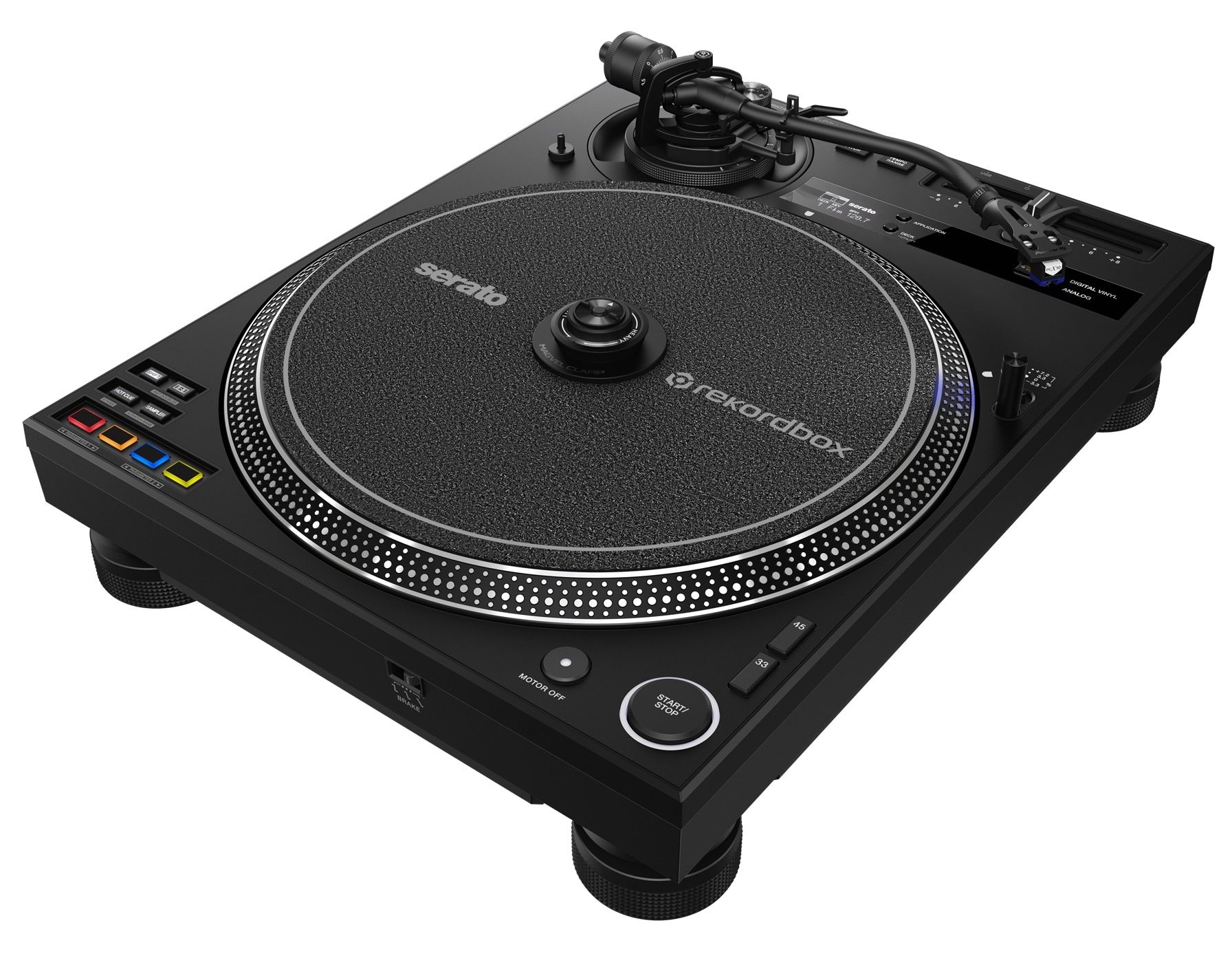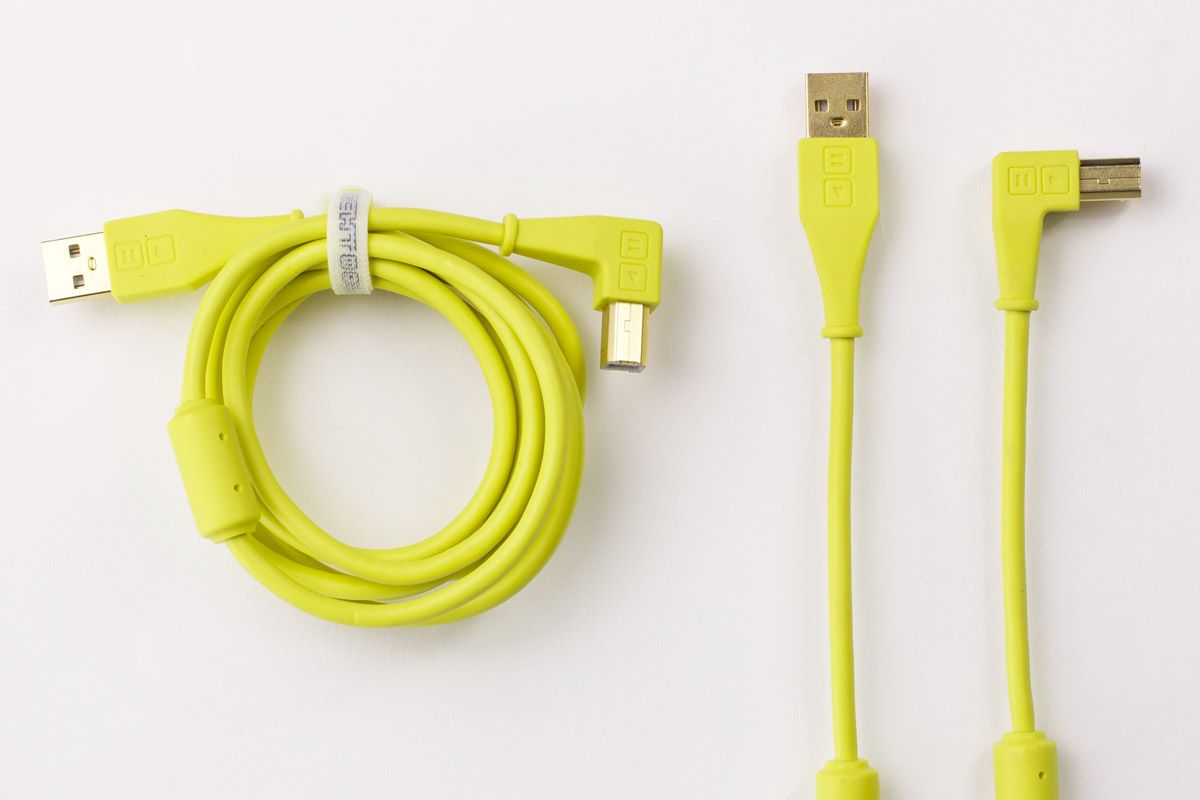Starting to DJ doesn’t have to be so expensive or intimidating that it freaks you out. We reviewed six DJ controllers for under $300 that include their own soundcards, high-level software, and enough features to see you through to your first gigs and beyond. Whether you’re looking for a fun hobby, a side income, or are gunning to be the next Aviciësto, these DJ controllers are only a small payday away.
DJ Controllers Roundup
Looking for more advance DJ controllers? Check out our reviews of the Traktor Kontrol S4 MK2 and the Pioneer DDJ SX. Also check out the latest DJ controller from Native Instruments, the Traktor Kontrol S8.
We have reviewed 6 great beginner DJ controllers including:
- American Audio VMS2 – (2 channels, solid build quality) – $249
- Gemini G2V – (2 channels, 8 pads per deck, large jogs) – $266
- Hercules DJ Control Air+ – (Velocity sensitive pads, light and portable) – $216
- Numark Mixtrack Edge – (Slim 2 channel controller) – $149.95
- Numark Mixtrack Pro 2 – (Multi mode pads, 2 channels, light weight) – $249.95
- Pioneer DDJ SB – (2 channels, Channel filters, Filter fade crossfader) – $249
Any habit worth picking up is usually expensive. DJing is no different, but at least it’s not videography or off-road racing. If you want to take up DJing today, all you’ll need is a fairly recent computer, your music collection, $300 or less for the street price of one of the following controllers, and some kind of speaker system with an RCA input. After that you’ll be you set until you decide you want to produce music, too, of course.
Although the following collection of sub-$300 DJ controllers doesn’t reflect every last bit of gear out there, it does illustrate the variety of styles, sizes, and software pairings available. All of them are two-deck units that include soundcards, hardware controls for track browsing and loading, jog wheels that toggle between vinyl-scratch and track-search modes, and microphone inputs (except for the miniscule Mixtrack Edge). They are all MIDI over USB units, so you can use them with any MIDI-compatible software. All of their included software programs integrate with your iTunes library, however, none of them are iOS compatible.
We barely broach the topic of sound quality in this round-up, because low-cost soundcard components have reached near parity over the last several years. You will certainly notice differences if you step up to higher-end gear, but whereas a decade ago there were brand names or price points that I wouldn’t trust to pass audio, that’s not the case in this round-up. All of the controllers here displayed adequate sound quality and output levels for DJing.
AMERICAN AUDIO VMS2
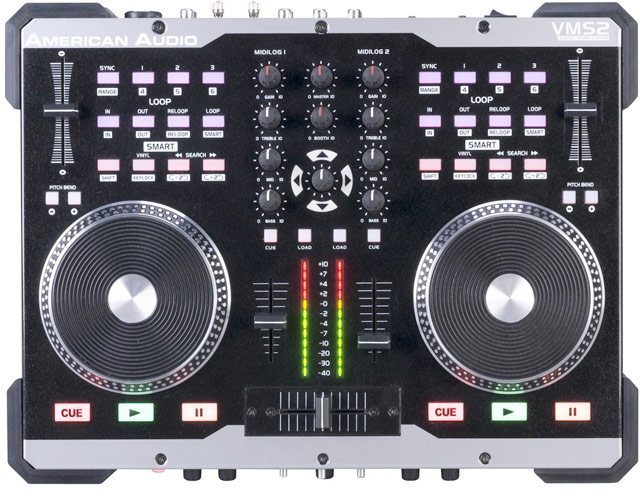
Price: $249.99 (on Amazon)
Communication: MIDI over USB
Ships with: Virtual DJ LE, USB cord, AC power supply, rack ears
Native support for other software: Mixvibes Cross 3, Traktor Pro 2, Virtual DJ Pro
Recording of DJ sets: Not in Virtual DJ LE
Channel filter knobs: No
Weight: 9 pounds (4.1 kg)
Dimensions: 15.75 x 12 x 2.5 inches (40 x 30 x 6.5 cm)
Minimum System Requirements (for Virtual DJ LE): Mac: OS X 10.5/10.6/10.7/10.8, Intel processor, 1 GB RAM. PC: Windows 7/8/Vista, Intel Pentium 4/AMD Athlon XP or newer, 512 MB RAM
The Good: Super-solid build quality. Nice set of audio connections. Innofader compatible.
The Bad: Lack of dedicated effects controls on the hardware. Old-style performance buttons, rather than pads.
The Bottom Line: This is definitely not the beauty queen of controllers, but it is a heavyweight contender. Seemingly purpose-built for mobile DJing, the sturdy VMS2 comes housed in pure metal, with thick rubber corner guards and rack ears for fixing into a rackmount case.
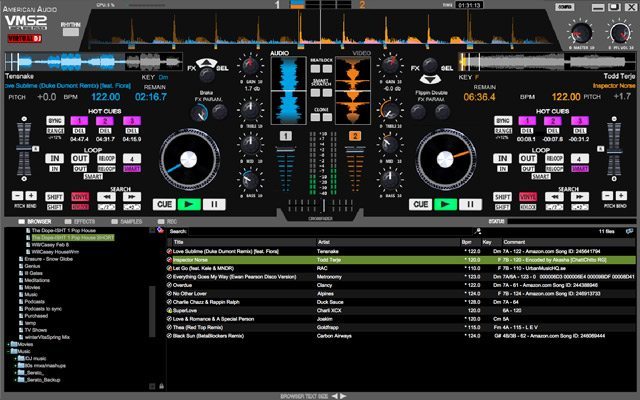
American Audio, a division of American DJ Group, doesn’t get a ton of hype in the DJ world, but it’s been cranking out reliable products specializing in mobile DJing and mobile audio for many years. If you’ve ever thrown your own homespun parties, you’ve probably looked into ADJ’s reasonably priced club lighting options.
The VMS2, the two-channel little brother to the more ubiquitous VMS4, sticks to the company’s mobile DJing rep. Its all-metal chassis is rare at this price, and it has the best selection of audio connections at this price as well. With two sets of phono/line RCA inputs, you can use the VMS2’s mixer section for external turntables or CD/media players, and for scratch DJs using external turntables, the VMS2’s user-replaceable crossfader is Innofader compatible. You also get a combo XLR/quarter-inch mic input, two master outputs (XLR and RCA), and RCA booth outputs with separate level control.
When using the VMS2 with the included custom Virtual DJ LE software, you can use the backlit performance buttons to control cue points and loops, but it’s a bit of a throwback performance section for a controller, lacking in dedicated controls for effects and the sampler. Of course, the effects and sampler of Virtual DJ LE leave something to be desired, but if you should upgrade to Virtual DJ Pro, or use the VMS2 with available mappings for Traktor Pro 2 or Mixvibes Cross 3, controls for effects and a sampler will be missed.
GEMINI G2V

Price: $479.95 (MSRP), $266 (on Amazon)
Communication: MIDI over USB
Ships with: Virtual DJ LE, USB cable, AC power supply with international adapters
Native support for other software: Traktor Pro 2, Virtual DJ Pro
Recording of DJ sets: No, not in Virtual DJ LE
Channel filter knobs: Yes
Weight: 10.2 pounds (4.6 kg)
Dimensions: 18.2 x 12.6 x 1.8 inches (46.1 x 32 x 4.5 cm)
Minimum System Requirements (for Virtual DJ LE): Mac: OS X 10.5/10.6/10.7/10.8, Intel processor, 1 GB RAM. PC: Windows 7/8/Vista, Intel Pentium 4/AMD Athlon XP or newer, 512 MB RAM
The Good: Impressive combination of solid chassis, audio options, expressive performance controls, and price. Harnesses as much power out of Virtual DJ LE out of the box as you could expect.
The Bad: Some sketchy control build quality. Virtual DJ LE software leaves something to be desired in the effects and sampler departments.
The Bottom Line: The G2V’s interface and version of Virtual DJ LE give you one of the most well-rounded feature sets out of the box at this price level. A beginning DJ has room to grow into this controller and has viable upgrade options to Traktor Pro 2 ($99) or Virtual DJ Pro ($249).
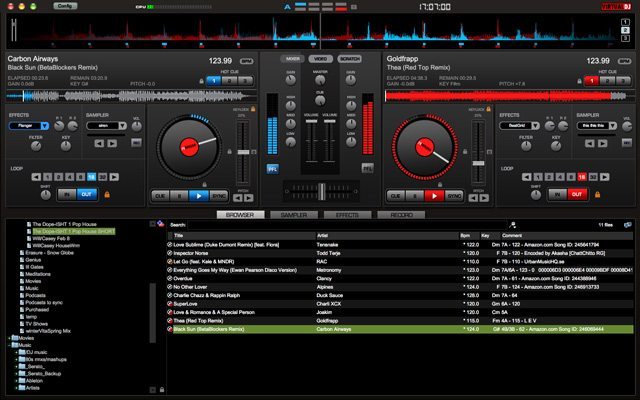
Hopefully many of you younger readers won’t even remember a time when the very name Gemini raised a red flag. The company has always produced DJ gear for the budget-minded, but either through its own efforts, simple supply-chain economics, or a combo of both, Gemini is now able to put together some very solid offerings for surprisingly low prices.
The G2V is the second unit of this collection seemingly built for punishing travel. Its all-metal chassis rivals that of the VMS2, and although it doesn’t have quite the connectivity options of the VMS2, the G2V supplies two master outputs (XLR and RCA), RCA booth outputs with separate level control, and an RCA auxiliary input that passes audio straight to the master out.
Some nice touches add flare to the controller, such as pre-fader channel level meters and crossfader deck assignment buttons. However, the G2V stands out even more with its performance controls and out-of-the-box functionality with Virtual DJ LE.
Every version of Virtual DJ LE adds some custom features for the particular hardware, while leaving out some features across the board, such as recording your sets. With the G2V’s eight performance pads per deck, you get five control modes in Virtual DJ LE: Hot Cue, Auto Loop, Sample, Loop Roll, and Manual Loop. That’s more pad variety than you get with the Serato DJ Intro controllers in this roundup. And the G2V has dedicated controls for the Virtual DJ effects and samplers.
These controls translate pretty well the Traktor Pro 2 mapping available from Gemini. That mapping gives you full control of Traktor’s copious effects, as well as eight hot cues and many looping options. The mapping could use some improvement by adding some sample triggering from the Remix Decks, though.
Not everything is aces with the G2V. Its pads are a little loose in the corners; the track Browse control feels a bit fragile; and the faders are a bit tight. Its large jog wheels are a matter of preference. Some will like them and their high-res 14-bit MIDI action. However, smaller versions would have about the same effect and reduce the footprint—and thus some of the weight—of the G2V.
HERCULES DJ CONTROL AIR+
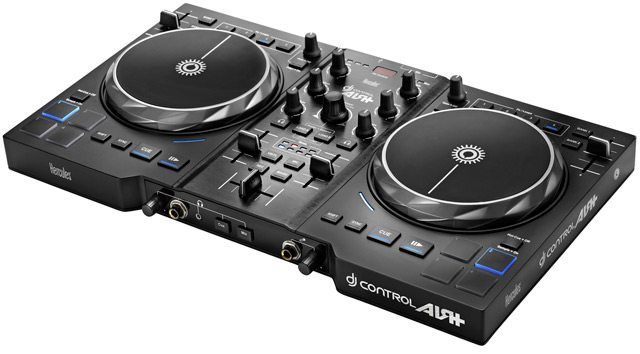
Price: $249.99 (MSRP), $216 (on Amazon)
Communication: MIDI over USB
Ships with: DJuced 40° software, USB cable (USB powered), paper quick-start guide
Native support for other software: Algoriddim DJay for Mac, Image-Line Deckadance, Mixvibes Cross 3, Traktor Pro 2, Virtual DJ Pro
Recording of DJ sets: Yes, from DJuced 40°
Channel filter knobs: Yes (shared with Gain knob)
Weight: 4.4 pounds (2 kg)
Dimensions: 17.9 x 10.2 x inches (45.5 x 26 x cm)
Minimum System Requirements: Mac: OS X 10.6/10.7/10.8, 1.6 GHz Intel Core 2 Duo, 2 GB RAM. PC: Windows XP/Vista/7/8, 1.6 GHz Intel Core 2 Duo or AMD 64-bit, 2 GB RAM
The Good: Well-placed, dual-mode velocity pads. Some fun features like Air Control and “Magic” loop slicing. 14-bit MIDI sensitivity. Lots of natively supported software.
The Bad: Over-sized jog wheels hog some of the real estate. Relies a lot on multifunction controls.
The Bottom Line: While it’s a decent controller with some interesting hardware/software features, it’s probably best reserved for those who appreciate large jog wheels with high-res 14-bit MIDI.
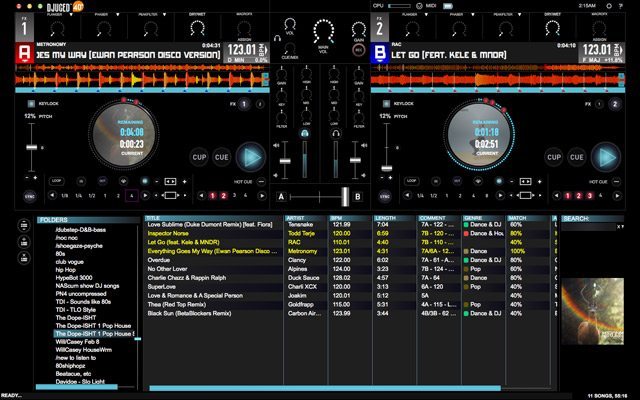
The DJ Control Air+ comes with the obscure DJuced 40° software, which doesn’t have a huge user community. However, on the plus side, DJuced 40° includes some nice features that most bundled freebie software doesn’t have, for example, recording your DJ sets to WAV and recording of your mic input with real-time effects. The controller also has a Magic button, which when used with DJuced 40° chops a running loop into four equal parts and sends them to the velocity-sensitive pads for triggering.
The Magic mode doesn’t work within other software, but the Air Control infrared beam does. Placed in the top center of the unit, Air Control sends a MIDI message according to your hand’s proximity over the beam. In default mode, Air Control manipulates the effect amount when you hold down one of the effect buttons to turn it on. It works well, but is a little sensitive, so that a pretty small range of movement is enough to turn an effect from 0 to 127.
Air Control is MIDI assignable, but Hercules does well to assign it to effect amount, because there’s no room for a dedicated effect-amount knob. A lot of the small DJ Control Air+ footprint goes to the large, pressure-sensitive jog wheels, which send 14-bit MIDI for 750 steps per rotation. With the precious space left, buttons double for effects and looping, knobs double for filter and gain, and there are four pads per deck rather than eight.
The pads, however, feel very nice. They are on the sensitive side, so you can trigger them with a lighter touch and with velocity sensitivity or not. Their dual modes cover cue point and sample recording/triggering.
DJuced 40° follows a layout similar to Traktor, and should users decide to switch to Traktor, the Hercules Traktor Pro 2 mapping does a nice job of integrating Remix Deck sample slot play/pause/delete and Flux Mode into the workflow.
NUMARK MIXTRACK EDGE
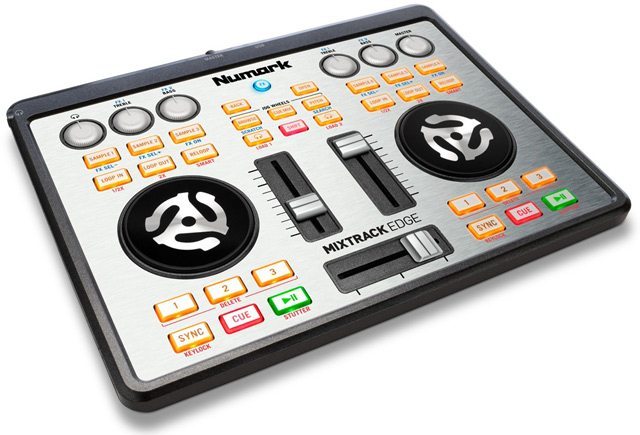
Price: $249.95 (MSRP), $149.95 (on Amazon)
Communication: MIDI over USB
Ships with: Serato DJ Intro, mini-USB cable (USB bus powered), stereo mini-to-RCA cable, paper quick-start guide
Native support for other software: Serato DJ, Traktor Pro 2
Recording of DJ sets: Not in Serato DJ Intro
Channel filter knobs: No
Weight: 1.85 pounds (0.84 kg)
Dimensions: 10.6 x 8.1 x 0.75 inches (27 x 20.5 x 1.9 cm)
Minimum System Requirements (for Serato DJ Intro): Mac: OS X 10.6.8/10.7.5/10.8.5/10.9, 1.6 GHz Intel Core Duo, 1 GB RAM. PC: Windows 7/Vista, 2.0 GHz Intel Core 2 Duo, 1 GB RAM
The Good: Lots of practical functionality packed into such an eminently portable controller. Five jog wheel modes, an FX layer, and a Shift key maximize the use of available controls.
The Bad: Some questionable management of the jog wheel modes. No mic input. Not iOS compatible.
The Bottom Line: In the absence of a mobile Serato DJing app (besides the controlling-only Serato Remote), the Mixtrack Edge represents one of the most compact ways to take Serato DJ Intro or the upgraded Serato DJ with you where ever you go. Making it iOS compatible would be even more appealing.
Numark picks up a lot of superlatives with the Mixtrack Edge. It’s the smallest, lightest, least expensive, and—let’s face it—cutest controller of this bunch. It’s also the most limited, and that’s to be expected because some features just had to go to make a DJ controller with a soundcard that’s scarcely bigger than a full-size iPad. However, the available space is optimized to better effect than a lot of its competition here, as well.
The small metal jog wheels rotate with little effort, and they operate in five modes, controlling track browsing, the cue mix, the pitch, track scratching, or track search. This method would work great except that the jog wheel mode doesn’t stay in scratch or search mode if you exit the FX layer.
Almost every other button or rotary has a second function as well, either through the momentary Shift key or the toggling FX key, which switches the six sample-launching buttons for Serato DJ Intro’s sampler to FX select and FX on/off buttons. The three loop buttons per deck pull double-duty for manual and autoloop functions. The three hard, almost flat cue buttons aren’t ideal, but they do the trick in the special case of this controller, and they respond well enough to play in rapid-fire succession if you apply enough pressure.
The three faders are also almost flat against the surface, however, they’re easy to grip with one or two fingers, and they have a very loose and slippery action that made them a pleasure to operate.
Considering that the Mixtrack Edge exists to be the most conveniently portable all-in-one controller out there (it even comes with an integrated protective cover, making it look even more like a tiny laptop), you can accomplish a lot with it when practicing or playing casually in Serato DJ Intro or the full Serato DJ. Unfortunately, it doesn’t work with iOS, which would seem to be a natural fit for it. However, Numark does include a firmware upgrading software utility for it, so maybe iOS compatibility will be added, oh, let’s say, on the same day that Serato releases its iOS DJing app?
NUMARK MIXTRACK PRO II
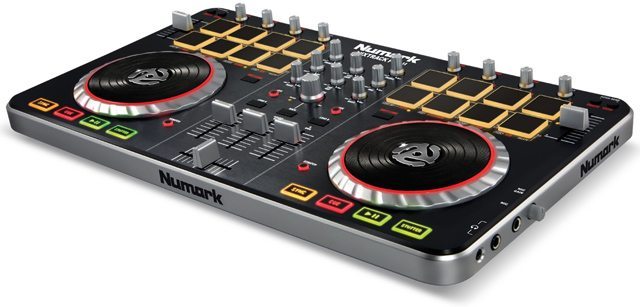
Price: $399 (MSRP), $249.95 (on Amazon)
Communication: MIDI over USB
Ships with: Serato DJ Intro, USB cable (USB powered), paper quick-start guide.
Native support for other software: Image-Line Deckadance, Mixvibes Cross 3, Serato DJ, Traktor Pro 2, Virtual DJ Pro
Recording of DJ sets: Not in Serato DJ Intro
Channel filter knobs: No
Weight: 4.7 pounds (2.1 kg)
Dimensions: 18.3 x 10.4 x 2.0 inches (46.5 x 26.4 x 5.1 cm)
Minimum System Requirements (for Serato DJ Intro): Mac: OS X 10.6.8/10.7.5/10.8.5/10.9, 1.6 GHz Intel Core Duo, 1 GB RAM. PC: Windows 7/Vista, 2.0 GHz Intel Core 2 Duo, 1 GB RAM
The Good: Excellent effects control section. Multi-mode pads. Great-feeling jog wheels. Well-rounded overall package.
The Bad: Pads are a little bit stubborn to trigger. No dedicated filter or gain knobs.
The Bottom Line: With its comprehensive effect section, versatile pads, and natural feel to the jog wheels, the Mixtrack Pro II makes a very solid choice for a Serato DJ Intro controller.
Effect tweakers can bask in the glory of the Mixtrack Pro II’s effects sections, as they’re the most comprehensive for a Serato DJ Intro controller that we’ve seen. Using pads, encoders, and the Shift key, it’s easy to select, toggle on/off, and adjust the effect amount for all three slots of the Serato DJ Intro FX decks. A fourth encoder selects the Beats time signature for tempo-synced effects.
The top row of pads also performs autolooping using the Shift button, and the bottom row of pads works in three modes: Manual Loop, Samples, and Cues. The pads can be a bit ornery to trigger; you have to hit them with some velocity.
These low-to-the-surface jog wheels feel very nice, and you can absolutely fly through tracks when using them to seek. They also have a nice extended side grip, so if you’re in Scratch mode, you can confidently use the sides to nudge a track faster or slower.
It’s unusual that the Mixtrack Pro II’s mixer includes neither Gain nor Filter knobs. But the EQ bands are center-detented, and like other Serato DJ Intro controllers, they fully kill the frequency band when rotated all the way left.
PIONEER DDJ-SB

Price: $299 (MSRP), $249 (in DJTT webstore)
Availability: Now
Communication: MIDI over USB
Ships with: Serato DJ Intro, USB cable (USB powered), paper quick-start guide
Weight: 4.6 pounds (2.1 kg)
Dimensions: 19.2 x 10.7 x 2.3 inches (48.2 x 27.2 x 5.8 cm)
Minimum System Requirements (for Serato DJ Intro): Mac: OS X 10.6.8/10.7.5/10.8.5/10.9, 1.6 GHz Intel Core Duo, 1 GB RAM. PC: Windows 7/Vista, 2.0 GHz Intel Core 2 Duo, 1 GB RAM
Native support for other software: Mixvibes Cross 3, Serato DJ, Virtual DJ Pro Full
Recording of DJ sets: Not in Serato DJ Intro
Channel filter knobs: Yes
The Good: Excellent feel and placement of pad performance section. Channel filter knobs and Filter Fade on the crossfader. Transitions well to Serato DJ.
The Bad: Anemic effects control section. Bottom four pads relegated to Play/Pause, Cue, Sync and Shift.
The Bottom Line: By all rights a great little budget controller, the DDJ-SB offers a little more in the pad performance and filter departments than you often see at this level. A couple of omissions are frustrating, but overall you get your money’s worth, and the DDJ-SB gets even better if you upgrade to Serato DJ.
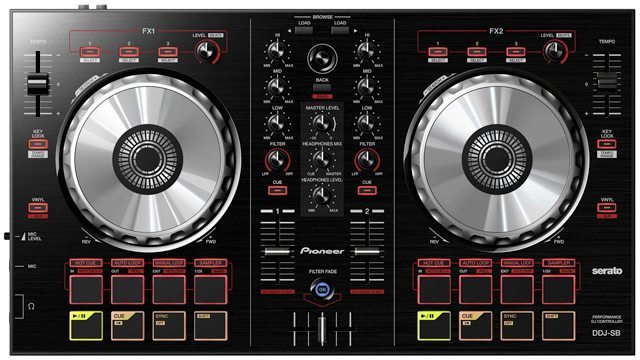
With the DDJ-SB, Pioneer delivers a much scaled-down version of its epic line that includes the DDJ-SZ, DDJ-SX, and DDJ-SR. The DDJ-SB keeps the eight pads per deck, well positioned for performance beneath the jog wheels, which retain the same comfortable feel and manipulability as on the other DDJ models.
The pads offer a nice medium-level resistance between too soft and too firm; they respond well, too, but are not as responsive in the corners as on higher-end controllers. It’s too bad that the bottom row of pads controls Play/Pause, Cue, Sync, and Shift; that feels like wasting a valuable resource. On the top row of pads, you get Hot Cue, Auto Loop, Manual Loop, and Sampler modes. Shift functions marked in red on the DDJ-SB show functions that are unlocked if you upgrade to Serato DJ, including additional pad modes: Hot Cue 5-8, Loop Roll, HotLoop, and Sampler bank switching.
Within the included Serato DJ Intro, the DDJ-SB gives you several features you don’t find on many competing controllers, including dedicated channel Filter knobs, a Filter Fade option, which when turned on mixes between songs on the crossfader by closing a filter on the outgoing track and opening a filter on the incoming track. It can be fun to experiment with, and can also be a way to fudge a passable mix that you were not quite prepared for.
For a controller at this price, the DDJ-SB has quality components; the knobs and faders feel firm and have solid center detents where appropriate. My biggest complaint is just that there are too few of them.
Particularly in the effects section, the controller would benefit greatly from three more knobs, like on the Mixtrack Pro II. Instead, the DDJ-SB has one knob per FX deck, and it alternates between tweaking the effects amount for all three effects at once, and when using Shift, controlling the Beats (synced effects’ time signature). Three buttons control FX on/off or FX selection using Shift. There definitely is room for more knobs in the effects sections. Pioneer may have been looking to save resources to keep the price low, but it’s almost as if the knobs were left off so that the inexpensive DDJ-SB wouldn’t be too good compared to its higher-end brethren.
Yet in the end, the DDJ-SB is still a better-than-average Serato DJ Intro controller, and a good value overall.
WRAP UP
By now we’ve confirmed what may always be the case: that budget-minded or starter equipment pretty much always comes with limitations. Each of these controllers’ limitations are unique, yet each one could get you on the path of beginning to DJ right away, which is why they’re here.
It would be disingenuous to try to pick an overall winner, because each person has his or her own particular goals and needs to fulfill. Instead, we’ll point out some of the best choices for what you’re after.
MOBILE DJ TANK: AMERICAN AUDIO VMS2
Often tied with AM radio DJing as the unsexiest subset of the profession, mobile DJing is probably not your ultimate dream, but it can be a great place to start. Whether in your own business or with a larger company, you can pick up valuable experience and some kind of paycheck before you even necessarily need to perform sophisticated mixes beyond simple radio-style fades.
The VMS2 comes with rack ears for mounting into rack cases that you’re likely to haul to jobs, and without the rack ears, thick rubber corner guards and a steel frame protect the unit during its travels. Its high-quality audio connection options are made for fitting the VMS2 into the centerpiece of a larger setup.
EXTREME PORTABILITY: NUMARK MIXTRACK EDGE
If you really want to keep it light on the go, or you live in a micro-space like a dorm room but don’t want that to stop you from DJing, the Mixtrack Edge lets you control Serato DJ Intro (or Serato DJ or Traktor Pro with upgrades) with admirable results for the amount of space and dollars it requires.
MOST READY FOR PRIME TIME: GEMINI G2V
If you want the controller that will suit the most scenarios out-of-the-box with no software upgrades, the Gemini G2V offers the most complete hardware/software combination. Like all of these controllers, it’s not perfect. It’s Virtual DJ LE software has a relatively weak effects section and sampler, but the G2V does give you dedicated controls for them. But the best part is the pad section. Its eight pads per deck give you five control modes in Virtual DJ LE: Hot Cue, Auto Loop, Sample, Loop Roll, and Manual Loop—more than any other controller here gives you out-of-the-box.
BEST UPGRADE PATH, SERATO DJ: PIONEER DDJ-SB
Any Serato DJ Intro controller will also work with Serato DJ if you pay the $129 upgrade free. However, not all of them will unlock as many hardware features for Serato DJ as the DDJ-SB does. Some of its upgrade features include a Panel button for switching between Serato DJ’s different panel views; a Vinyl Slip mode, which lets you scratch and then returns to the uninterrupted playback position; and extra pad modes: Hot Cue 5-8, Loop Roll, HotLoop, and Sampler bank switching. The extra cue points and Loop Roll mode alone should be worth the money.
BEST UPGRADE PATH, TRAKTOR PRO 2: YOU DECIDE
There’s no clear-cut winner here. Three of the controllers offer factory Traktor Pro 2 .tsi controller template maps: the Hercules DJ Control Air+ ($315 after $99 Traktor Pro purchase), the Gemini G2V ($365 after $99 Traktor Pro purchase), and the Numark Mixtrack Pro II ($349 after $99 Traktor Pro purchase).
The DJ Control Air+ is the least expensive, and incorporates both Remix Deck sample triggering and Flux Mode in the mapping. The Mixtrack Pro II makes good use of its pads to control FX decks and to offer three additional pad modes for cue points, Remix Deck sample triggering, and loops. However, it doesn’t include the crucial Flux Mode in its default map. The Gemini G2V map gives you excellent FX deck control and access through its pads to eight cue points, eight Auto Loop lengths, Flux Mode, and other looping features, but it doesn’t offer sampling options, for some reason. If you feel confident in making your own changes to default mappings, I would lean toward adding sample triggering to the G2V map.
Have a favorite entry-level controller? Tell us about it in the comments below.
Please support Dj TechTools editorial by checking out our selection of dj controllers in the store!


